With Wimbledon 2016 starting on Monday, let's take a look a look at some interesting facts, figures, history and trivia of the oldest Grand Slam
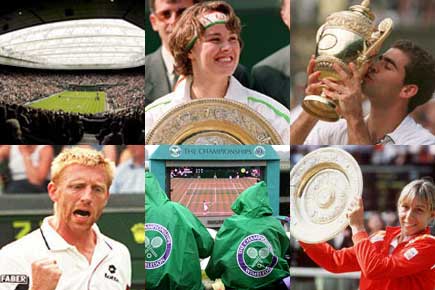
Welcome to SW19: An in-depth walk through Wimbledon's history
With Wimbledon 2016 starting on Monday, let's take a look a look at some interesting facts, figures, history and trivia of the oldest Grand Slam.
ADVERTISEMENT
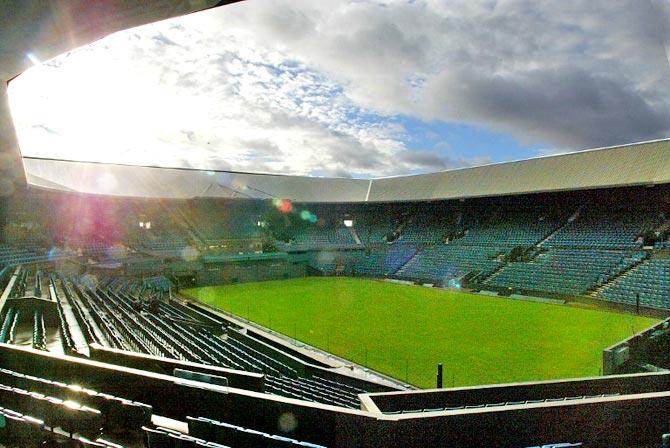
The All England Lawn and Tennis Club in Wimbledon. Pic/ AFP
ORIGIN
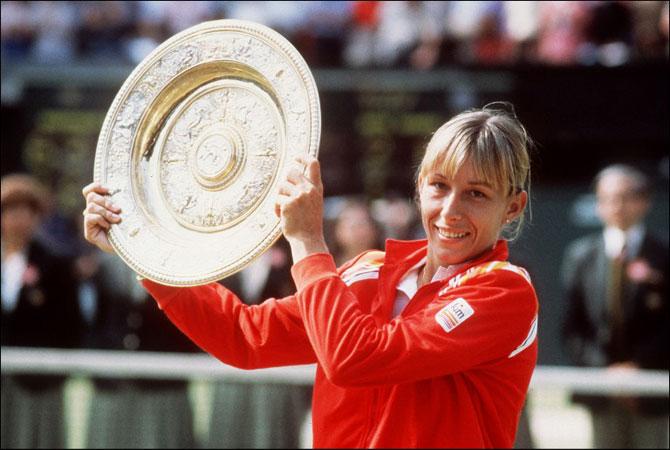
US tennis champion, born Czech, Martina Navratilova holds the trophy after winning 1982 Ladies' Singles at Wimbledon for the third time, beating her country fellow Chris Lloyd in the final. Pic/AFP
Wimbledon began in the year 1877, at the All England Club, in the London suburb of Wimbledon. Wimbledon started as only Gentlemen's Single Championship, in which only 22 players participated. There were only 200 spectators in the first Wimbledon tournament and the tickets were sold for one shilling each, in the final match. The winner of first Wimbledon Gentlemen's Single was Spencer Gore, an old Harrovian rackets player. On July 19, 1877, Gore beat fellow Brit William Marshall 6-1, 6-2, 6-4 to become the first-ever Wimbledon men’s singles champion.
Women's Singles tennis events were started in 1884. Initially, 13 players entered the tournament. The first win of the tournament was registered by Maud Watson.
Ladies Single Championship and Gentlemen's Double were introduced in Wimbledon in 1884.
ONLY MOTHER TO WIN AT SW19: EVONNE GOOLAGONG IN 1980
The Australian tennis player beat Chris Evert in the Wimbledon final to win her seventh and final Grand Slam. In the process Evonne became the first mother in 66 years to win a Wimbledon title. Goolagong went on to retire in 1983.
ONLY GRASSCOURT GRAND SLAM
Wimbledon is the only major tennis tournament still played on grass. Both the Australian Open and US Open were once played on grass. These courts were used at the Australian Open until 1987 and the US Open until 1974.
PRIZE MONEY
Players at The Championships 2015 received a total of £26.75m – that meanth the total prize money rose by a whopping 7% from 2014. 1.88m pound was on offer for each of the singles champions – the highest ever in professional tennis.
DEFENDING CHAMPIONS
Novak Djokovic (Men's Singles)
Serena Williams (Women's Singles)
LONGEST MATCH
The longest match played at SW19 was in 2010 on Court 18. It was played over three days.
'Marathon Man' John Isner (USA) beat Nicolas Mahut (FRA) 6-4, 3-6, 6-7 (7), 7-6 (3), 70-68 in a match that lasted 11 hours and five minutes, with their final set lasted 8hrs 11mins. It lasted so long that it was suspended because of darkness two nights in a row.
MOST ACES IN ONE TOURNAMENT
In 2001, Croatian Goran Ivanisevic netted 212 aces, while Americans Alexandra Stevenson (1999) and Serena Williams (2008) both hit 57 aces.
FASTEST EVER SERVE
American Taylor Dent holds the record for the fastest ever serve at SW19 with a 148mph ace against Novak Djokovic in 2010.
Venus Williams represents the women in this category, having hit a 129mph serve in 2008.
RAINY DAYS
Only seven Wimbledon tournaments have been played without rain interruptions since 1922. Those were 1931, 1976, 1977, 1993, 1995, 2009 and 2010.
HAWK
Rufus the Hawk is a Harris Hawk used by the All England Lawn Tennis and Croquet Club to keep pigeons away from their venue. Described as an "important member of the Wimbledon family", Rufus has been scaring away the birds for five years,[2] taking over from the previous hawk, Hamish.
BALL BOYS AND GIRLS
There are more than 200 ball boys and ball girls used to collect tennis balls during Wimbledon. There is an eight-hour-per-week training spanning for four months before the tournament begins.
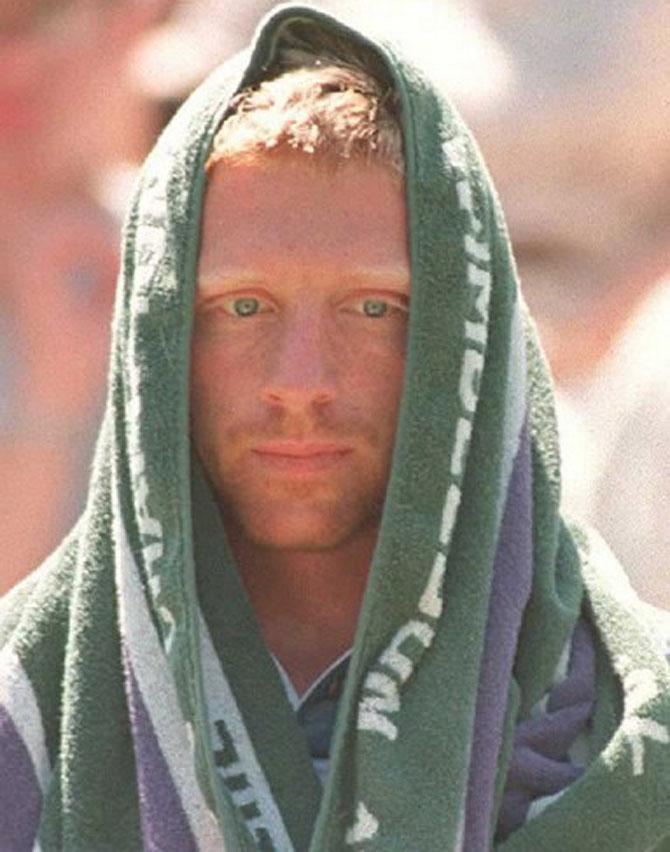
Boris Becker of Germany in 1996 during a Wimbledon Lawn Tennis Championships tie. Pic/AFP
BALLS USED
Approximately 54,250 are used during The Championships.
ROYAL BOX
The Royal Box has 74 seats. In 2003, a long-standing tradition of Centre Court players bowing or curtseying to the Royal Box was discontinued by order of the Duke of Kent, President of the Club since 1969, who deemed it an anachronism in modern times. The only exception would be if the Queen or the Prince of Wales were to attend.[31] Andy Murray and Jarkko Nieminen elected to bow when the Queen visited The Championships for their 2010 2nd Round match, as did Roger Federer and Fabio Fognini at their 2nd round match, watched by the Prince of Wales, in 2012.
REFRESHMENTS
Around 350,000 cups of tea and coffee are sipped during the fortnight, while viewers drink 230,000 glasses of Pimm’s and around 100,000 pints of draught beer and lager, Also 142,000 portions of English strawberries are eaten.
SHORTEST PLAYER
The shortest tennis player to participate at Wimbledon was Miss C.G. Hoahing who was just 4 feet 9 inches.
FIRST OVERSEAS WINNER
The first overseas winner was American May Sutton who was the ladies' champion in 1905. Australian Norman Brookes was the first foreign gentlemen's champion when he won it in 1907.
FIRST PLAYER DISQUALIFIED FROM WIMBLEDON
The first-ever player to be disqualified from Wimbledon was Britain's Tim Henman in 1995 during a men's double match when he hit a ball girl.
LONGEST WIMBLEDON CAREER
French Jean Borotra, who was born on August 13, 1898, entered in the men's singles event 35 times between 1922 and 1964 -- a 55 years span. His last title came at the age of 41. In 1977, he appeared in the Veterans' Doubles aged 78.
YOUNGEST MALE WINNER
The youngest male champion is Boris Becker (West Germany) who won the men's singles title in 1985, aged 17 yr 227 days.
SHORTEST MATCH IN WIMBLEDON HISTORY
The 1881 Wimbledon final saw William Renshaw defeat John Hartley, 6–0, 6–1, 6–1, in a match that lasted just 37 minutes.
MAXIMUM TITLES
Martina Navratilova has won Wimbledon Women Singles maximum numbers of time i.e. 9 times. She also shares a record of winning 20 Wimbledon titles, an all-time record, with Billie Jean King.
MAXIMUM TITLES IN MEN'S SINGLES
Willie Renshaw and Pete Sampras hold the record of winning the Wimbledon Men Singles a maximum of 7 times.
In the Amateur Era, Renshaw (1881–1886, 1889) holds the record for most titles in the Gentlemen's Singles, with seven victories. Renshaw's wins, however, came within the challenge round format, and he won the event only twice after going through a complete draw. Renshaw also holds the record for most consecutive titles with six from (1881 to 1886). The record for most consecutive and most wins post challenge round during the Amateur Era is Fred Perry (1934–1936).
In the Open Era, since the inclusion of professional tennis players in 1968, Pete Sampras (1993–1995, 1997–2000) and Roger Federer (2003–2007, 2009, 2012) co-hold the record for most victories with seven. Björn Borg (1976–1980) and Roger Federer (2003–2007) co-hold the record for most consecutive victories with five.
YOUNGEST WINNER
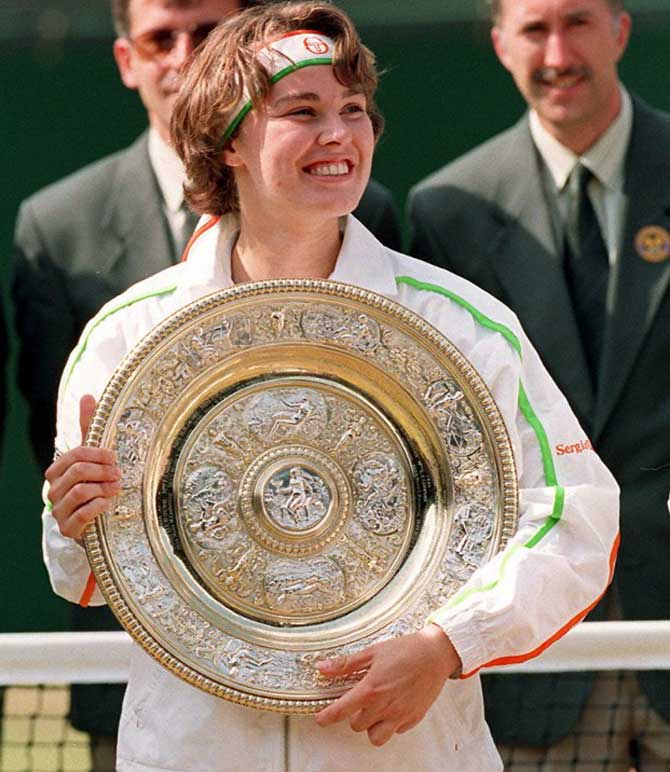 Swiss Martina Hingis beams with delight as she holds the Women's Singles Trophy in1996 after beating Czech Jana Novotna at the Wimbledon Championships. Hingis won the match 2-6, 6-3, 6-3 becoming the youngest champion this century. Pic/AFP
Swiss Martina Hingis beams with delight as she holds the Women's Singles Trophy in1996 after beating Czech Jana Novotna at the Wimbledon Championships. Hingis won the match 2-6, 6-3, 6-3 becoming the youngest champion this century. Pic/AFP
Martina Hingis became the youngest player to win a Wimbledon title, at the age of 15 years, 282 days, by winning doubles championship in 1996.
SOME OBSCURE TRIVIA
Champions who wore headgear in a singles final
33 players, including John McEnroe (“Broad Red Headband”) in 1981, Martina Navratilova (“Thin Purple Ribbon Headband”) in 1990, and Conchita Martinez (“Broad Navy Blue Headband”) in 1994, have worn a headgear in the singles final.
2016 is the 130th edition of the event
The recent 2015 Wimbledon championships was the 129th edition of the event.
Interruptions
Wimbledon has been interrupted on twice – during the First and Second World War.
Attendance
Over 500,000 people attend the Wimbledon tournament every year making it the biggest tennis tournament on grass.
Borota love affair
France’s Jean Borota clinched his first title in 1924 and 40 years later he still competed in the tournament. He went on to play at the Wimbledon veterans in 1977 at the age of 78.
MOST
The Compendium does not record how a Miss M.H. de Amorim of Brazil felt about entering the record book for having served 17 consecutive double faults to begin her match at Wimbledon in 1957. She lost. As did Miss L. Anderson of Great Britain, who served 11 consecutive double faults in a 1946 match.
Goose Eggs
16 men have lost 6-0, 6-0, 6-0 from 1878 to 1987. 125 women have been eliminated 6-0, 6-0.
Winners who have climbed into the stands at Wimbledon
Five men and six women have climbed into the stands after winning the tournament: Pat Cash (1987), Martina Navratilova (1990), Steffi Graf (1993, 1995), Jana Novotna (1998), Venus Williams (2000), Pete Sampras (2000), Goran Ivanisevic (2001), Lleyton Hewitt (2002), Maria Sharapova (2004), Amelie Mauresmo (2006) and Rafael Nadal (2008).
According to the Wimbledon Compendium, “immediately” after winning a title on Centre Court, these players “scaled the terraces to the Players’ Match Seats Box to embrace their kin or supporters.”

US' Pete Sampras kisses the cup after winning the men's singles final at the Wimbledon Championships in 1997 against French Cedric Pioline . The final was won by Sampras 6-4, 6-2, 6-4. Pic/AFP
Important Dates
Wimbledon championship celebrated its centenary in 1977.
The roof of the Center Court was increased by a height of one meter, in 1979, thereby providing room for another 1088 seats.
The centenary of the Ladies' Singles championship was held in 1984.
The year 1986 is one of the significant years in the history of Wimbledon, because its 100th championship was celebrated with great fanfare.
The 100th Ladies' Championship was commemorated in 1993.
BEYOND THE COURT
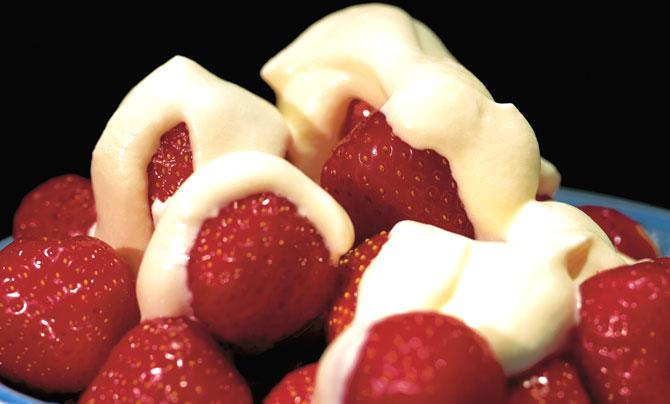
Strawberries and Cream
This traditional English dessert is served to spectators during the tournament. The combination of Strawberries and cream was created by cardinal Thomas Wolsey in the court of King Henry VIII. It is a staple during every Wimbledon.
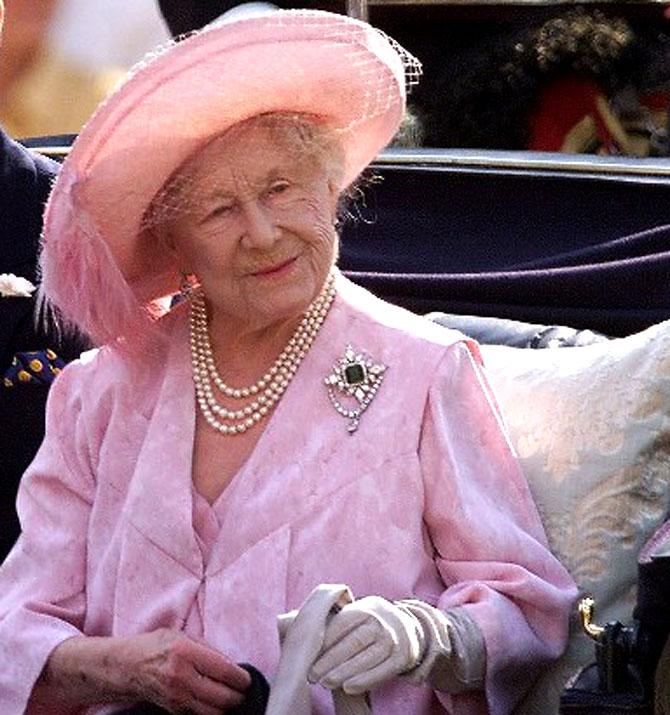
Queen Elizabeth II. Pic/AFP
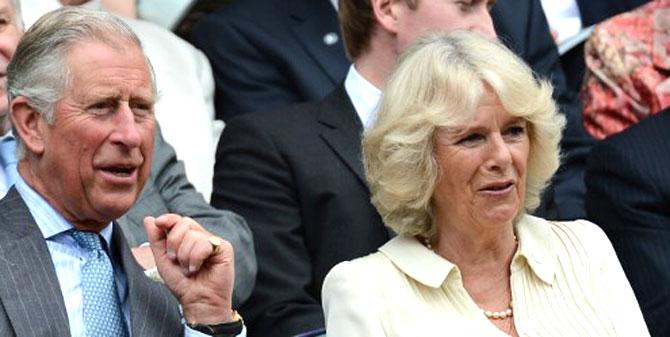
Prince Charles (L) and Camilla, Duchess of Cornwall (R) in the Royal Box on Center Court before the second round men's singles match between Switzerland's Roger Federer and Italy's Fabio Fognini on day three of the 2012 Wimbledon Championships tennis tournament at the All England Tennis Club in Wimbledon, southwest London, on June 27, 2012. Pic/AFP
The Royal family
Players were obligated to bow and curtsy to members of the Royal Family seated in the Royal Box upon entering or leaving Centre Court. The President of the All England Club, His Royal Highness the Duke of Kent, decided to discontinue the tradition in 2003. Now, players are required to bow only if HRH The Prince of Wales, or Her Majesty The Queen is present, as was in practice during the 2010 Championships when the Queen was in attendance at Wimbledon on 24 June. Roger Federer famously mentioned in his post-match interview in 2012 that he and his opponent had been asked to bow towards the Royal Box as Prince Charles and his wife were present, saying that that was no problem for him.
A part of television history
Wimbledon was also involved in a piece of television history, when on 1 July 1967 the first official colour television broadcast took place in the UK. Four hours live coverage of the 1967 Championships was shown on BBC Two (then the only colour channel in the UK), and although footage of that historic match no longer survives, the Gentlemen's Final that year is still held in the BBC archives because it was the first Gentlemen's Final transmitted in colour.
Theme music
The BBC's opening theme music for Wimbledon was composed by Keith Mansfield and is titled "Light and Tuneful". A piece titled "A Sporting Occasion" is the traditional closing theme, though nowadays coverage typically ends either with a montage set to a popular song or with no music at all. Mansfield also composed the piece "World Champion", used by NBC during intervals (change-overs, set breaks, etc.) and at the close of broadcasts throughout the tournament.
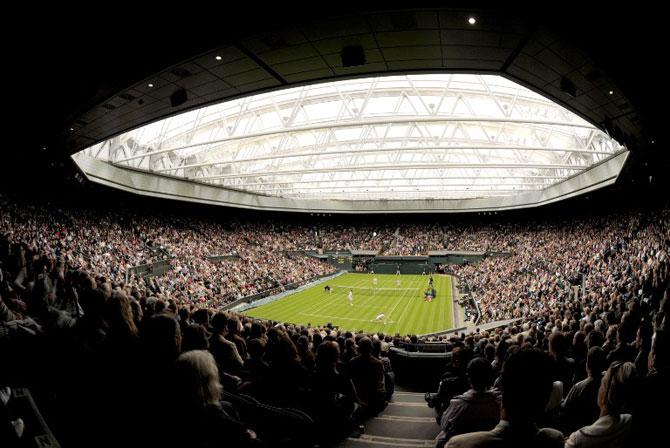
The retractable roof on Centre Court at the All England Lawn Tennis Club, Wimbledon, England. Pic/AFP
The retractable roof
Wimbledon's Centre Court was fitted with a retractable roof to lessen the loss of playing time due to rain in 2009. It takes up to 10 minutes to close, during which time play shall be suspended. However the time to transfer from outside to inside play can be up to 45 minutes while the air-conditioning system acclimatizes the nearly 15,000-seat stadium for indoor-grass competition. The tournament rules for the Wimbledon fortnight dictate the roof must remain closed until the end of the match, so some matches may be completed indoors, even though the sun has re-emerged. The roof was closed for the first time during a competitive Championships match at about 4:40 pm on Monday 29 June 2009, during the fourth round Ladies Singles match between Amélie Mauresmo and Dinara Safina. The first full match to be played with the roof closed was a men's singles fourth round match between British player Andy Murray and Switzerland's Stanislas Wawrinka.
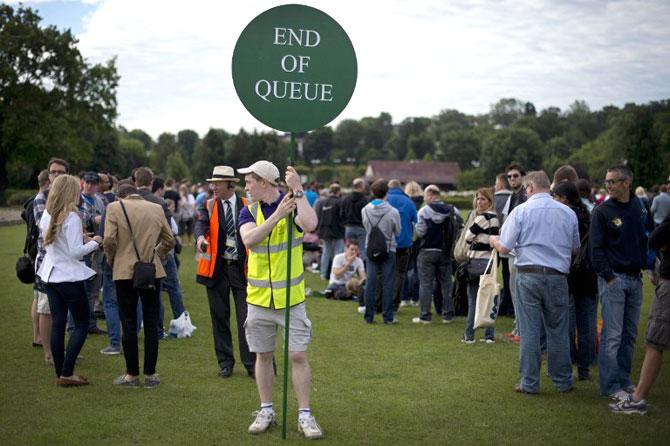
A steward holds a sign as tennis fans queue for tournament tickets to watch the action on the second day of the 2012 Wimbledon Championships. AFP PHOTO
No tickets? Don't worry!
Wimbledon and the French Open are the only Grand Slam tournaments where fans without tickets for play can queue up and still get seats on the three show courts on the day of the match.

Tennis fans sitting on "Henman Hill" as rain delays the start of the sixth day of the 2007 Wimbledon championships. AFP PHOTO
Henman Hill
At the northern end of the grounds is a giant television screen on which important matches are broadcast. Fans watch from an area of grass officially known as the Aorangi Terrace. When British players do well at Wimbledon, the hill attracts fans for them, and is often renamed by the press for them: Greg Rusedski's followers convened at "Rusedski Ridge", and Tim Henman has had the hill nicknamed Henman Hill. As both of them have now retired and Andy Murray is the number 1 British player, the hill is occasionally referred to as "Murray Mound" or "Murrayfield", as a reference to his Scottish heritage and the Scottish ground of the same name, but this has largely failed to catch on – the area is still usually referred to as Henman Hill. None of these nicknames are official.
 Subscribe today by clicking the link and stay updated with the latest news!" Click here!
Subscribe today by clicking the link and stay updated with the latest news!" Click here!






